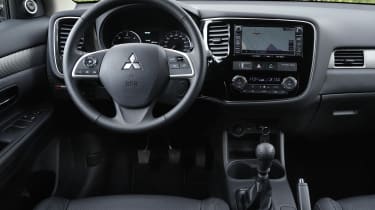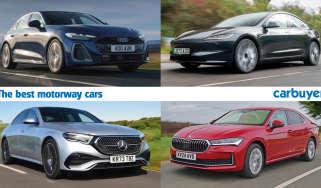Used Mitsubishi Outlander buying guide: 2012-present (Mk3)
The Mitsubishi Outlander is an alternative choice in the crossover market that includes an intriguing plug-in hybrid option
Crossovers are in strong demand in the UK, and the Mitsubishi Outlander is one of the pioneers in the class. The third generation is arguably the best yet, with a spacious interior that can be had with five or seven seats, plus a range of trims that are well-specced for the price.
There's the choice of a 2.2-litre diesel, or the intriguing PHEV plug-in hybrid variant to consider. The Outlander was the first crossover to offer a plug-in hybrid drive system, and its combination of a petrol engine and electric motor is a unique proposition that boosted the car's appeal, especially for urban buyers after a car with low tax bills but plenty of carrying capacity.
Mitsubishi Outlander Mk3 history
There have been three generations of Mitsubishi Outlander. The first was sold from 2003-2006 in modest numbers, while the second version that replaced it was a joint venture that was also sold as the Peugeot 4007 and Citroen C-Crosser. This was replaced by the Outlander Mk3 in 2012, although without any Peugeot or Citroen counterparts.
At launch, the sole engine option was the 2.2-litre DI-D diesel that was carried over from the previous model. There are two outputs available, 156 or 174bhp, with the former only available with Mitsubishi's twin-clutch SST semi-automatic gearbox. Trim levels comprised GX1, GX2, GX3 and GX4, while there was also a sparsely equipped 4Work commercial version. The diesel model was offered in five or seven-seat guises.
The PHEV plug-in hybrid joined the range in 2014, and it instantly boosted the Outlander up the sales charts, because it was the first plug-in hybrid crossover to go on sale, and its low emissions and spacious interior proved to be a winning combination.
More reviews
The model initially launched in GX3h and GX4h trims, while the more upmarket GX4hs and GX5hs arrived later. Unlike the diesel, the PHEV is a five-seater only, due to the hybrid running gear taking up space in the back of the car, and it only comes with an automatic gearbox.
The range was facelifted in 2015 with a bold new grille, while the only engine options from then on were a 147bhp 2.2-litre diesel with an automatic or manual gearbox, or the PHEV version.
Which is the best Mitsubishi Outlander Mk3 model for me?
While the Mitsubishi Outlander is available as a five or seven-seater, we wouldn't recommend the latter if you're going to be carrying more than five people on a regular basis. The third-row seats are tricky to access and quite cramped when you get there, and when they're not in use, they take up boot space.
Avoid the 4Work model, because it's the commercial version and isn't designed for family life. The GX2 is reasonably well equipped, and early cars are now dipping below the £10,000 mark, although they will have a high mileage.
If you want lots of kit, then the GX4 is a good choice, although the only early cars you're going to be looking at are diesels. There is the option of front or four-wheel drive, plus six-speed manual or twin-clutch auto, although the latter comes with a less powerful version of the 2.2-litre DI-D diesel.
If you're looking at Outlanders from 2014 onwards, then the big choice is whether to go for diesel power or the PHEV hybrid, and that all depends on the kind of driving you normally do. If you do plenty of motorway miles and long distances, then the DI-D diesel is still the car to go for, because the hybrid will turn to petrol power the faster you go. But if you do a lot of short, urban trips, then the PHEV is a better bet.
Of course, this all hinges on whether you have the facility to plug the car in and charge it in the first place, but if you do, you could drastically reduce your petrol station visits.
Running costs, maintenance and parts
Mitsubishi abandoned petrol power when the Outlander Mk3 was launched in the UK, so the sole choice in early cars is a 2.2-litre DI-D diesel. This returns 46mpg and CO2 emissions of 162g/km in manual 2WD guise, while the 4WD version has figures of 43mpg and 169g/km, so road tax is slightly more expensive.
The SST automatic version had a 156bhp diesel (the gearbox wasn't strong enough to cope with the full 174bhp of the manual), but the 4WD model was also thirstier, at 39mpg, and had CO2 emissions of 189g/km. Later cars did improve on these figures, while the later automatic model wasn't far behind the manuals for emissions.
The headline figures for the PHEV hybrid look stunning, but real-world driving will give you vastly different results depending on how you drive it and how often you plug the car in to charge up the battery.
Emissions of 44g/km mean the Outlander PHEV is road-tax-exempt, while claimed fuel economy of 148mpg is a pretty far-fetched sum that even Mitsubishi claims will be tough to attain.
Plug in regularly and go no further than the claimed battery range of 32 miles, then you'll definitely reap the benefits, but if you use the 2.0-litre petrol engine to recharge the battery, you can expect 30mpg from the car.
Another downside of Outlander ownership, irrespective of powertrain, is Mitsubishi's relatively high service and maintenance costs. As the car is built in Japan, spares need to be sourced from the same location, so costs are naturally higher, while dealer service leaves a little to be desired, according to our Driver Power customer satisfaction survey.
What to look out for
The Mitsubishi Outlander Mk3 is a development of the model that preceded it, so it should be reliable, while Mitsubishi's knowledge of building rugged and dependable 4x4s and pickup trucks means the Outlander should be up to the job of family life.
It's always worth checking on four-wheel-drive models that there aren't any knocks or clunks from the transmission, especially if the car you're looking at has been used for towing. The 4WD lock mode should engage and disengage smoothly, too.
There's nothing in particular that you should be aware of with the PHEV version, and the battery pack will be covered by an eight-year warranty to cover any unforeseen circumstances.
Recalls
There has been one recall on the standard Mitsubishi Outlander Mk3, and it relates to a poorly fitting oil seal on the transfer box of cars equipped with an automatic transmission. Cars affected were built between September 2012 and April 2013.
As for the Outlander PHEV, there is a single recall on that, too, relating to an incorrectly fitted fuel pipe that may cause a leak. This affects cars built between mid-July 2015 to mid September 2015.
Alternatives
If you need a seven-seat SUV, then the Kia Sorento and Hyundai Santa Fe are a better option than the Mitsubishi Outlander, because their rearmost rows are more spacious. They are also better at towing, thanks to their more powerful diesel engines.
Another decent seven seater is the Chevrolet Captiva. As Chevrolet no longer sells cars in the UK, you can pick up a Captiva for a lot less than before, but while standard kit is generous build quality isn't as good as the Outlander.
Closer to home, the Honda CR-V is built in the UK, and is more efficient than the Outlander, but it's a strict five-seater, and so is the Toyota RAV4, which is also slightly smaller inside, too.
There aren't any direct SUV rivals for the Outlander PHEV. If you want low emissions and decent space, then early examples of the Outlander are matched by the Toyota Prius Plug-in on price, while later cars are rivalled by the Audi A3 etron and Volvo V60 Hybrid.
None of these cars will have as much space as the Mitsubishi, but the Audi and Volvo will be better to drive, and the Prius should travel further before needing recharging, too.
Verdict
The Mitsubishi Outlander Mk3 is a bit of an also-ran in the crossover sector, because it doesn't really excel in any single area. There are more spacious seven seat SUVs on offer, there are rivals that offer more interior and boot space, and the diesel isn't the most efficient model out there.
However, if you can make the Outlander PHEV fit into your lifestyle, it has a lot more appeal. You'll reap the benefits in terms of low fuel costs and free road tax, while Mitsubishi's excellent reliability record applies to whichever model you might choose.
















